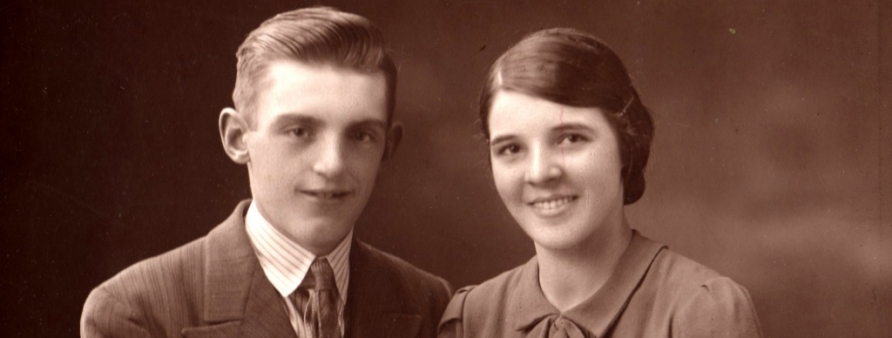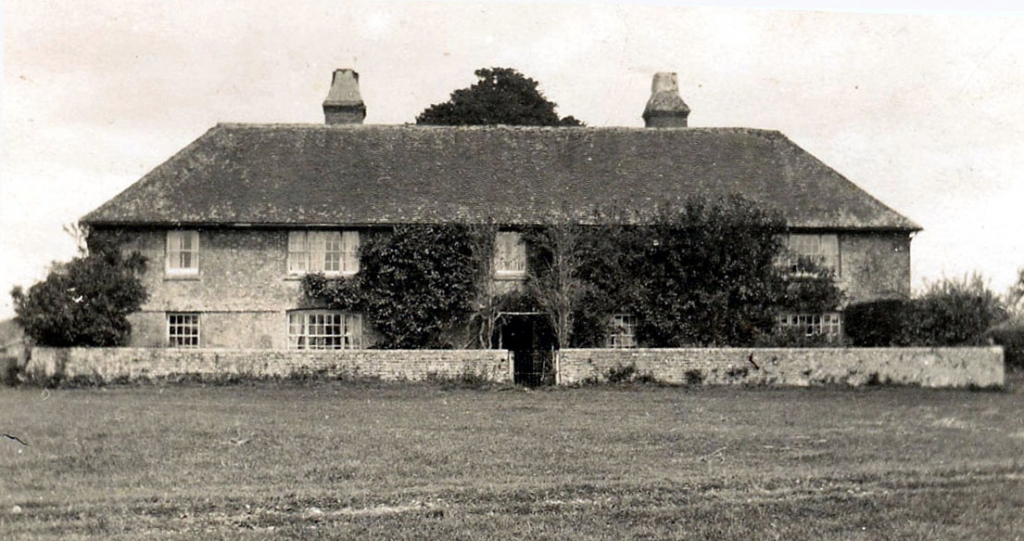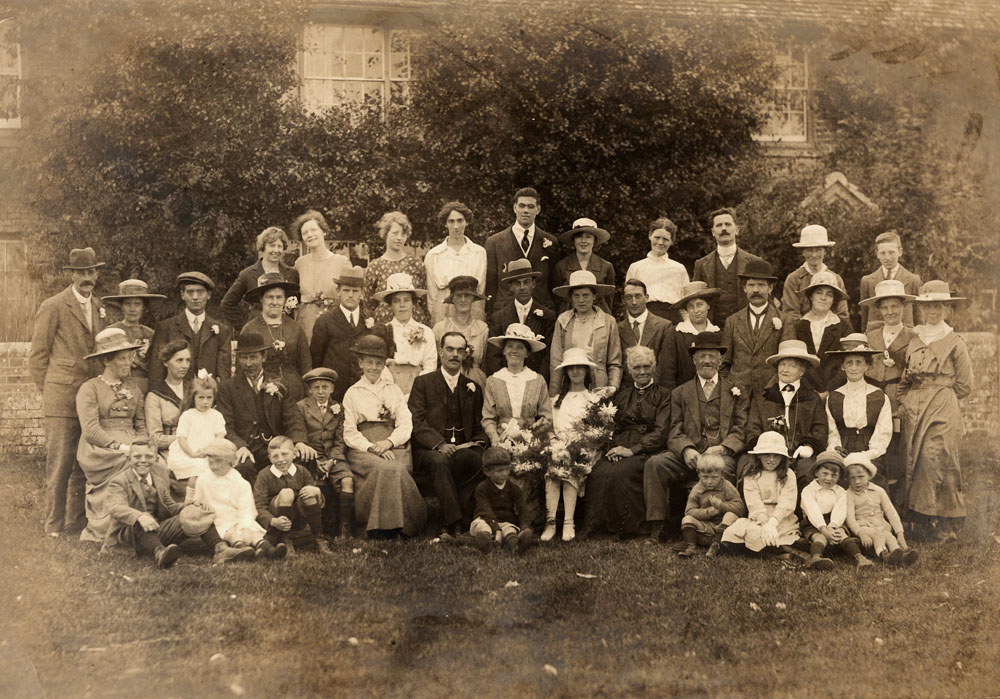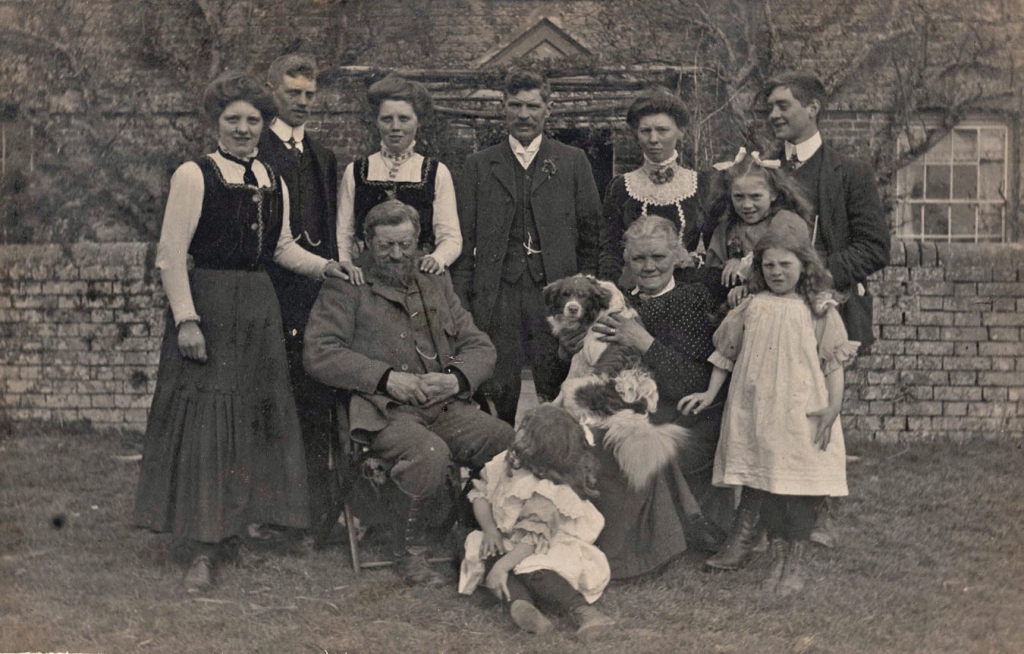Halland Sussex
Bentley was a Tudor manor house and in earlier days has been the home of members of the Gage family. Although new doors and windows had been inserted in the 18th century the house was basically Tudor with huge chimneys and stone and brick floors, except in the best room downstairs. As one looks at Bentley, either now or in photographs from the early part of this century the chimneys and windows (either original or restored) are two constant features. A third is the presence of two great yew trees which stand on something of a rise behind the house, and which can be seen over the top of the roof.
One of my uncles, who came to Bentley in 1890 as a boy, told me shortly before he died, aged 91, that he had recently visited Bentley and to him the trees seemed just the same as they did in 1890. When he was young someone came to visit the house who had lived there many years before as a young man; in his opinion the trees looked in the 1890’s much as they had done in about 1840.
In the 1920’s the front garden was enclosed in a brick wall with half round bricks at the top. There was a wrought iron gate leading to the front door through a rustic pergola covered with pink climbing roses. Just inside the gate were two Gingko Biloba trees (still there) which were planted in 1907-8 by my grandmother, with the help of my mother. To the right of the gate as you entered was a brick mounting block, whose top was about level with the top of the wall – ideal for young children to climb and play on. There was a square yew bush at the right extremity of the house; this now marks the join of the old house and the Raymond Erith extension. At the front door there was a brick and wooden porch with a tiled roof.
On entering the front door there was a rather dark hall extending beyond the staircase to a rear door, which led out onto a paved space. This was known as the area, but we children always thought of it as a moat, although there was no water in it. At the back in was bricked up to a height of about 3 feet to retain the higher ground behind. Under the staircase was a door leading down steps into the cellar which seemed very dry; it had what I suppose was a drain leading down to what use to be a pond in the corner of the Lower Park. Rumour had it that in days gone by this was used by smugglers.
Turning right at the front door there was a passage leading along to what was known as the Sitting Room, or Drawing Room. This was a fine room 18ft by 19ft, which was full of solid Victorian furniture. On the walls were pictures of Queen Victoria, Edward VII and his coronation, and colour illustrations of the Battle of Omdurman in 1898. It has not changed much, except that a window has been put into the rear wall. On the left of the passage (now part of the passage) was the small room my grandfather used to do his accounts and diary. He and his wife used to sit there in the evenings.
On the left of the front door was the kitchen; it used to have a brick floor and the bricks were worn and uneven. The beams were plastered over. The room has not altered much today, although the floors have been changed, and the beams have been exposed (and perhaps added to!). There was a large chimney where a black Victorian kitchen range had been installed for cooking, this led into the large chimney in the scullery. There was an oak settle with a high back which can be seen in the photo in the 1936 sale particulars. This together with a fixed screen on the other side of the fireplace, kept the draughts away from this area of the room. In the left hand corner of the room was a door leading into the front scullery, and one in the right hand corner leading to the second scullery. The front scullery had a floor which was partly stone flagged and partly brick. From it the back door led to the outside, although this was at the side of the house rather than the back. Stretching from the door into the back corner of the house was an old stone sink with a pump, from which all the water required in the house was drawn. There was a large plate rack over the sink. Quite close was an old brick oven in which faggots were burnt, it was occasionally used but most of the cooking was done in the kitchen range. There was also a large open fireplace where faggots and logs were burnt actually in the hearth; there were large hooks above for hanging saucepans and kettles, and bacon and hams were also hung there to smoke. The chimney was open to the sky and you could stand in the hearth and look up and see daylight. There was also a copper in this room, and the smoke from it went into the big chimney.
The second scullery was used for storage; at one time poultry were kept in here in wooden cages while they were fattened up for market. The pantry, or dairy, originally stretched from the front of the house to the secondary staircase, and had a door from the kitchen and from the scullery. It had slate shelving and had all the equipment for separating milk and making butter. In my memory butter was only made occasionally, but in earlier days it was the regular practice. The present office was formed from the pantry. There was also a small room known as the incubator room as in earlier days it had housed an incubator for chickens.
Upstairs there were four bedrooms in the front part of the house, reached by a gently sloping staircase with an oak balustrade on the landing. There was a spacious landing with a window over the front door. Immediately on the right at the top of the stairs was a bedroom known as the Blue room; almost opposite the stairs was another bedroom over the second scullery. My grandparents’ room was in the centre of the front of the house, over the kitchen and part of it had been partitioned off to make a dressing room with a door to the rear staircase. In my childhood this dressing room was used to store apples, and the smell of apples always takes me back there. Along the corridor was the best bedroom in the house, which was over the sitting room and similar in size. There was a secondary staircase from the scullery which lead to three further bedrooms and a further staircase to the attics, where there was another bedroom and then a roof space with no lights.
Many years later my father said to me “That was a good arrangement. The girls slept in the rooms reached by the main stairs, and the boys and men in the rooms reached by the rear staircase, the old man slept in the room in between, so there could be no hanky-panky!” Of course, there were always some farm hands sleeping in the house.
At the side of the house by the back door was a courtyard, as can be seen in old photographs. By the back corner of the house was a gate leading into the garden. Then there was what was known as the lodge, which was where my grandfather stored the meal and corn for feeding the pigs and poultry. There was also a copper in here where potatoes were cooked for the pigs. By the side of this was a lean to structure in which logs were kept. In the courtyard was a drain over which pigs were killed by the butcher with a knife. Just handy there was also a quantity of coal, brought by the wagon from Isfield station. There was no gas, electricity or mains water, all heating was from coal or wood, with oil lamps and candles for lighting.
Just over the wall from the courtyard was the enclosure for ducks and geese and, a little way up the path to the stackyard and farm buildings, were the pig sties. There were originally three of these, but my grandfather built three more after he bought the farm outright in 1921. In the days before combine harvesters the corm and oats were cut by binders and, after standing to dry, were brought into the stackyard and stacked until the threshing contractor came. Then the corn and oats were sold and the straw stacked again for use as bedding for the animals. Hay was also stacked for use in the winter for cattle food. In the autumn the years was full of stacks which diminished through the winter. Threshing was quite an event – the steam engine came in under its own power and was used to operate the thresher, all was smoke and dust. At the end of the stackyard farther from the house was a small brick building used for cooling the milk and putting it into churns to be sent away to the dairy. Water was from a spring and reduced the temperature of the milk as it travelled down through the cooler.
In the stable yard beyond there was stabling for 4 cart horses, which were worked in two teams. There was also a stable and cart shed (now used as café) for two horses, a cart horse used as a single unit and the pony who pulled the milk float, used in the early days for transporting milk to Isfield station and for trips to market with calves, pigs or sheep. It also pulled the governess cart which was used for trips to Uckfield or Lewes for shopping, the market or the bank. There were also cow sheds on this yard and on the boundaries there were 2 old barns, one of which had what were reputed to be medieval remains. My own theory about the derivation of the name, Bentley, is that, as the place was alleged to be on monastic origin, it may have been Benedictine. A frequent abbreviation of St Benedict is St Benet, so may it not be St Benet’s fields – Benet-leys? Mr Askew was reporting as saying that it meant burnt fields, but I think this is wrong. If it were Brent Ley, yes. I have also seen a derivation as windy fields. Richard Pratt was forward looking and had a Fordson tractor in the early 1920’s when they were not very plentiful.
There were also extensive gardens and when the family were single and lived at home all the boys had a plot of their own, and the girls helped their mother with the flower gardens. As the ground behind the house was sloping the gardens had three levels, with one step between each. At the top level on the left had side were two WC’s. All the gardens were enclosed in a wall, probably dating from very early days. This wall, punctuated by occasional gaps, went right round the gardens and joined up with the Granary (no longer extant), which was situated several yards from the house, beyond a field gate into the garden. The Granary was used to store potatoes on the ground floor and wheat upstairs; there was also a lodge and an Oast house.
In the garden adjoining the Granary was the Monkey Cage – an enclosure made of wire netting in which soft fruit was grown – raspberries, loganberries, gooseberries and currants, white, red and black. On the other side of the garden was an orchard with apples, pears and plums. As can be seen from old photographs there were espalier pears on the front wall of the house and there was also a grape vine on the rear wall in the area; whether the grapes ever ripened I don’t know. After I was 5 we were only ever there in school holidays and they were always still green then.
The above photo was taken at Archibald (Frank's father) and Kate's wedding in 1920 a year before Frank was born. It was taken in front of Bentley Farm House.
Life at Bentley was isolated and frugal. There was plenty of good plain food but not much in the way of luxuries. There was plenty of milk and eggs from the farm and groceries were delivered once a week. A representative called one day for the order and the goods were delivered a day or so later. In the early days bread was baked in the bread over in the scullery and butter was made in the dairy. Later the baker called, I think twice a week. A pig was killed from time to time providing pork, bacon, sausages and liver as they say that everything is edible expect the squeak. About 1926 new regulations came in so pigs could be no longer killed on the premises but had to be taken to a licensed slaughterhouse.
Before the days of the car the only people who came to Bentley were friends, relations and tradesmen. The house is the best part of a mile from the nearest road – either Harry Lane or Knoll Lane towards Halland. In my youth there were usually about a dozen people sitting down to meals when we were there – my grandparents, the remaining unmarried son and daughters of the house and us. There were one, or sometimes two, men living in the house, and Ted Cox, who used to come up from Ringmer to work at the farm, which he did for quite some time, had his breakfast and dinner in the house, as did Bess Homewood, who helped in the house.
As befitted the son of a preacher Richard and Ann were regular attenders at Chapel. I understand that in the early days at the Lower Mount they walked across the fields to Shortgate and then to East Hoathly. In 1886 the Independent Chapel was built by Mr Charles Matthews in Halland and the family attended there; a number of descendants are still involved in the chapel.
There were originally four cottages on the farm, occupied by farm workers. Two quite close to the farm house were called Pump House and were probably what had been the source of the water supply to the house. They were near the little stream that ran through the farm, and the supply may have come from the stream or from springs. When I was very small Uncle Jesse lived in one end of the pair and the other was occupied by Charley Durrant and his wife, with their son and daughter. Charley Durrant worked at Bentley for many years, and for a time his son, also Charley, also worked on the far, before he went into the army. He eventually came back to the Hailsham area.
Later my grandfather built a new pair of cottages called Peace Cottages and Uncle Jesse moved into other of those, and the other was occupied by Charley Lessiter who was also employed on the farm, working there for many years. Up to that time he lived at the cottage at Crumps Corner, at the junction of the Ringmer, Isfield and Iron Peartree roads; one of sons, Fred, still lives at Peace Cottages. For many years he lived there with his brother George, now dead; neither of them ever married. An older brother, Ern, also worked at Bentley when I was a small boy.
Then a family called Marchant came to Pump House and the father, and at one time two sons, worked on the farm. One brother, Tom, who had been wounded in the Great War, and was alleged to have a silver plate in his head, didn’t stay long, but his younger brother Fred was there until my grandfather retired.
There was another paid of cottages at Little Bentley, now, I believe, demolished. In one end lived Dick Homewood with his wife, who was the sister of Mrs Durrant at Pump House, and their daughter Bess, who worked in the house from the time she left school until 1928. Dick was the shepherd on the farm for many years. There were various people living in the cottage at the other end. Bess Homewood married Fred Marchant after they left Bentley and they lived in White House after Uncle Alex and Aunt Grace had left there. Both couples remained in close touch all their lives. In addition there were men living in the house most of the time. One called Will Tester was there up until Grandad retired. He fascinated me as a child because his father worked at the sawmills at Plashett Park nearby and Will had once caught his hand in a saw and had only one finger and a thumb on one hand. Frank Hoad lived in for several years; when Uncle Joe married Frank went with him to Hailsham and stayed there for some years. In earlier days other relatives were also employed, among them Sam Wickens, Richard Pratt’s nephew and later son-in-law. Tom Burfoot, another nephew, who, after 1928, worked for Albert Starnes at Crockstead, and a family of Smiths who were cousins.
Another photo taken in front of Bentley Farm House. Frank's mother Kate is on the extreme left of the photo. Frank's Grandad and Grandma are seated in the centre.
The farm was about 350 acres in extent and was a mixed farm. There were about 50 milking cows, a flock of sheep, a number of pigs in six pig pounds, and ducks, geese and chickens kept in an enclosure near the house. There were 5 cart horses and one pony. Wheat, oats, maize and potatoes were grown and hay and root crops for cattle feed.
I was an odd child and didn’t get out with the men a lot, although I used to talk to them from time to time. I used to like wandering around on my own and walked around most of the farm at one time or another. There were two woods – one called Bentley Wood, which was quite extensive, and a smaller area called Crumps Wood. Then there were one or two smaller clumps of trees called “shaws”, and the Plantation, which was a line of beech trees situated quite near the house. There were three ponds, two near the house and one further off in the Park; that was the name of the field through which the road came into the farm from Ringmer – Isfield road.
When staying there in 1925 in sunny weather my brother George and I spent a lot of time in the bigger pond near the house with planks which served as warships from the First World War; both of us got badly sunburnt backs which was very painful. When I was about 18 months old workmen doing some repairs in the house left some lime ready to mix for mortar; George and I were playing with a ball which went into the lime. I went in after it and got lime in my eyes and was blind for several days; it was feared that I might be permanently blind but fortunately this was not the case.
We used to have one day at the seaside during the summer holidays. We would set out early in the morning and walk across the fields to Shortgate where we caught the bus to Brighton. We had buckets and spades and dug about in the shingle (no sand at Brighton!). We use to have a ride on Volks electric railway which ran along by the sea from near the Aquarium to Black Rock. One year we went in a rowing boat, and even my mother, who was not fond of the water, was persuaded to have a go. Unfortunately there were also another couple with a small child; once we got started it became obvious that the man was drunk. Mother did not like drunks and was upset so we quickly went back to land to lose ourselves amount the crowd which had begun to gather.
This document was written by Bert Ansell, son of Mabel who married Cecil Ansell. Their photos are on the "Extended family" page. Thanks to Rosie Ansell for correcting the spelling and attributing the extensive history.
|







